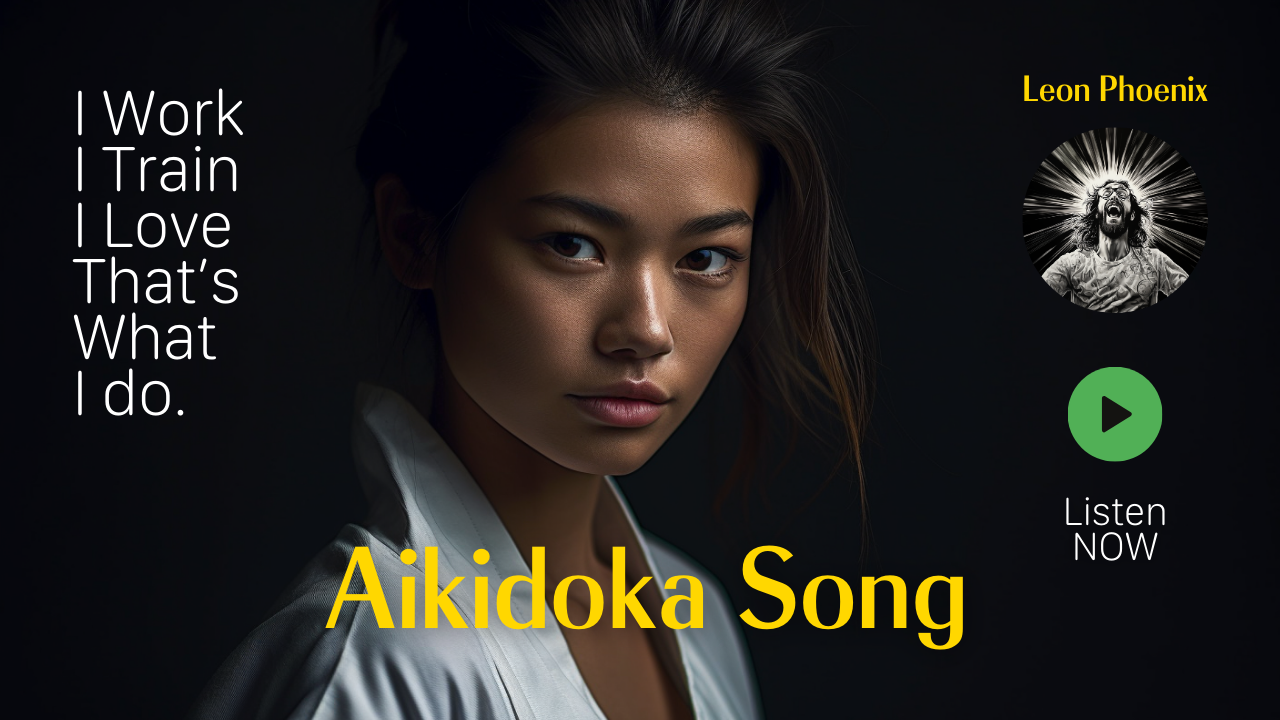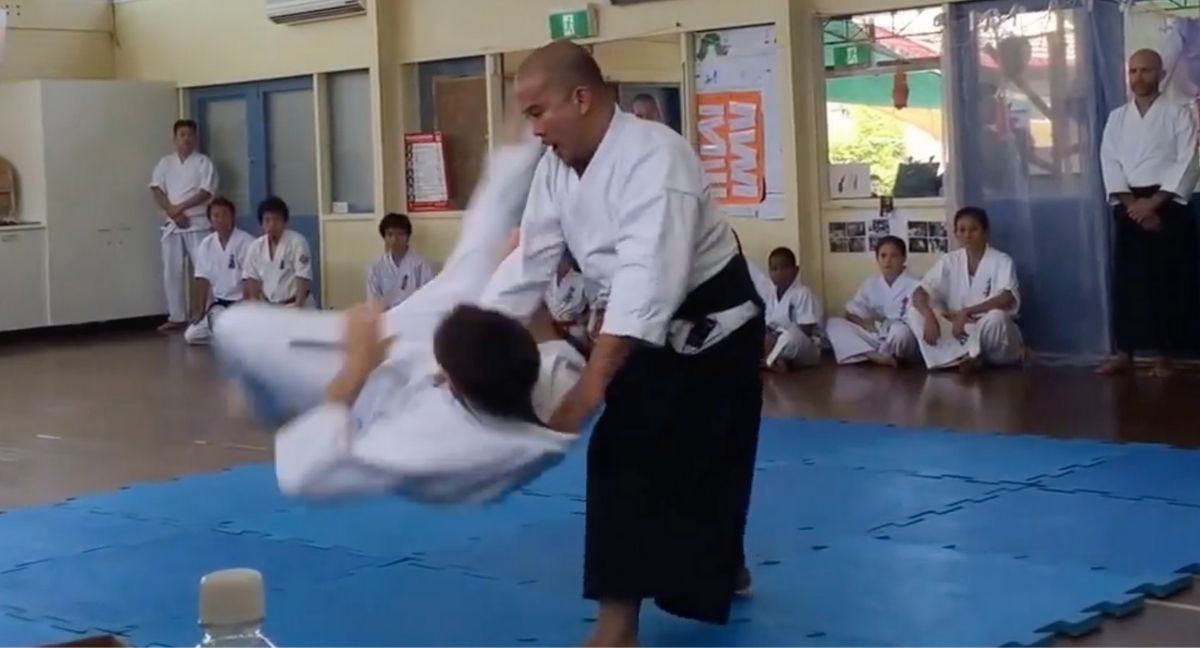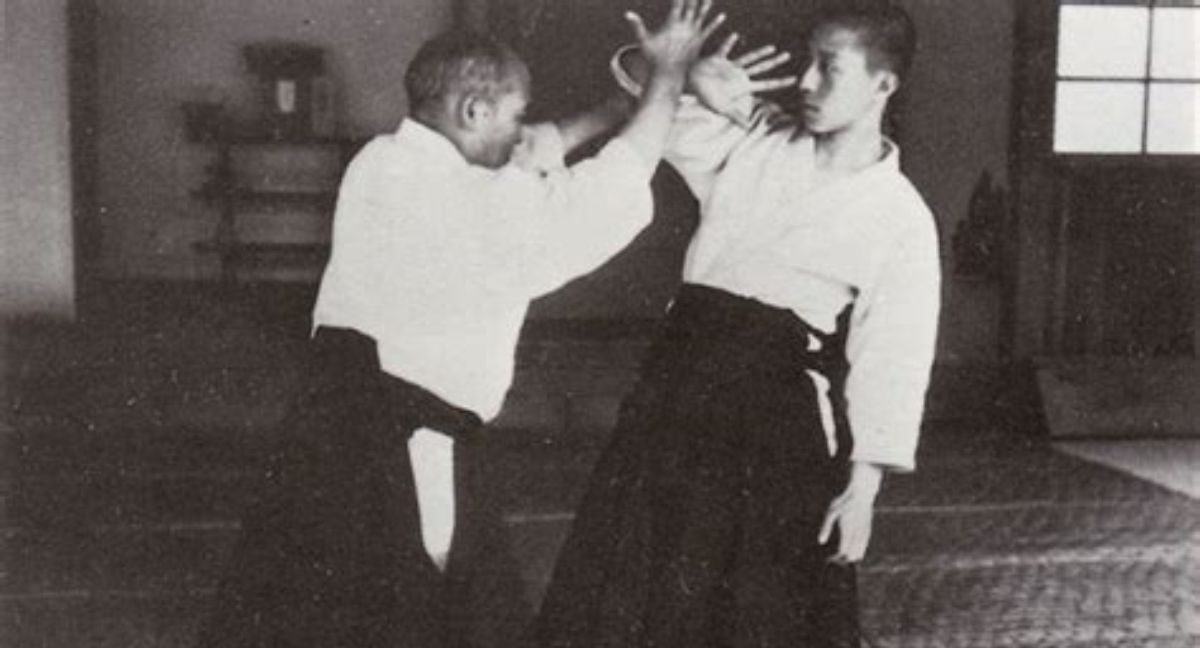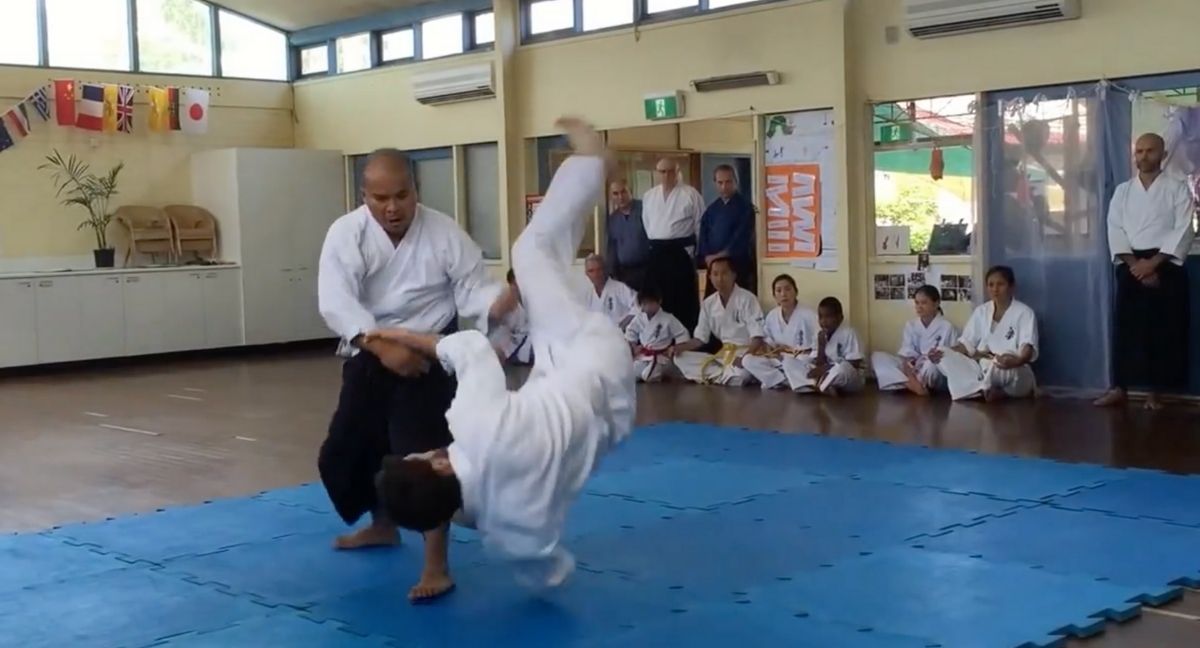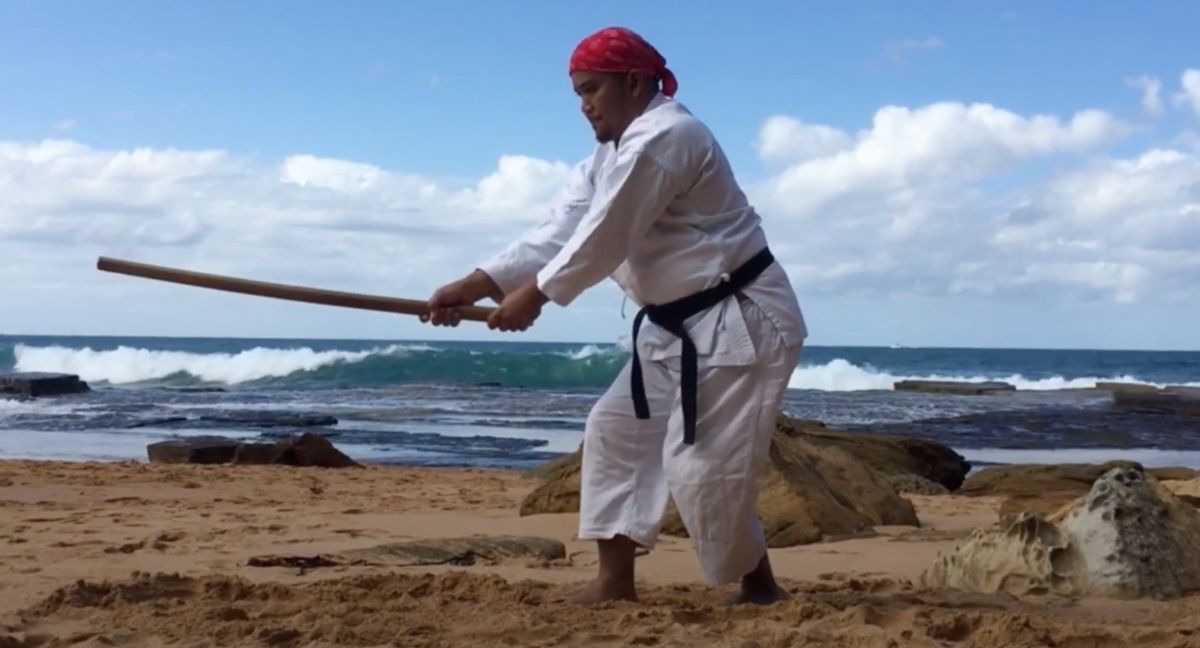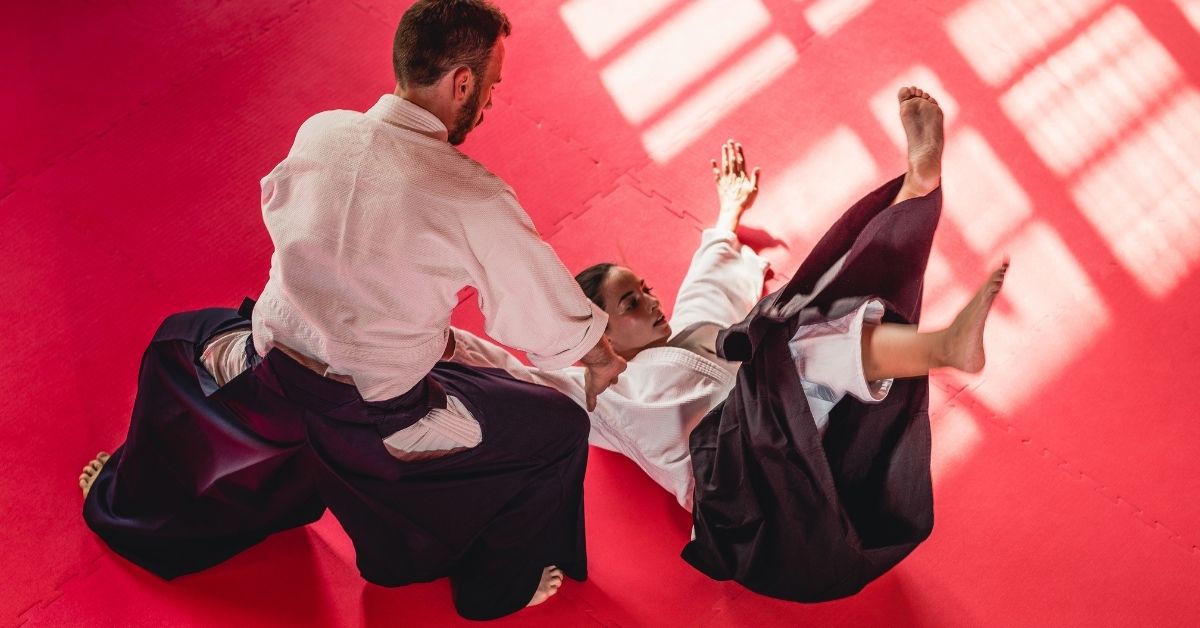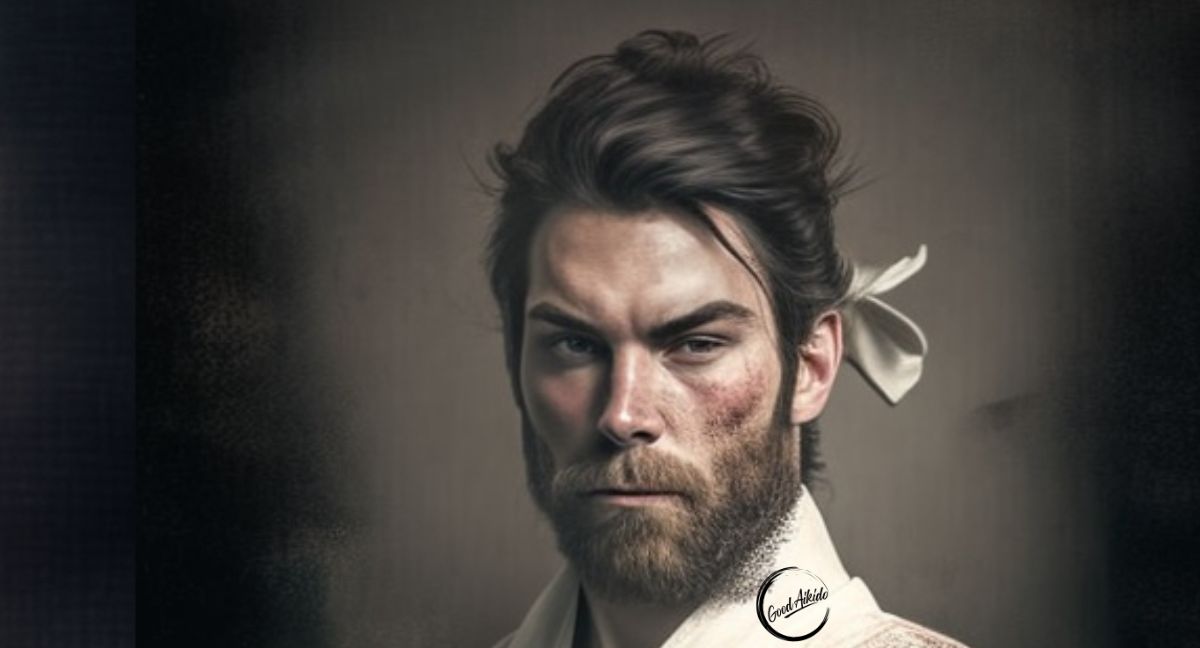Aikido Words and Glossary
Aikido words are Japanese words and terms unique to the dojo (school and place to train). Although you can use them in the dojo, these terms may or may not be used in everyday Japanese conversation.
For example, we use the term ‘Keiko (稽古) to describe a class. In everyday Japanese conversation, Keiko is specifically used to describe ‘martial art training or practice’. So one cannot really say “I am going to Art Keiko” when what you meant was “I am going to Art Class”.
Having said this, these Aikido Words are part of everyday Aikido training. We believe that Language, in general, is the gateway to culture, hence if one knows these Japanese Aikido Words, one will enter and experience the Japanese culture too, even if you are in Australia.
Oh by the way. If you are reading this post on a mobile, it is best to read the glossary on a landscape position.
Aikido Words, Terms, and Glossary
| TERM | JAPANESE | MEANING |
|---|---|---|
| Aiki | 合氣 | The character 合 ai means “join” or “to come into conformity with.” 氣 Ki is energy, especially the universal, primordial energy that moves all of nature and is the basis of human vitality. Ki is the life force energy that flows through every living thing. Ki is also known in cultures as Chi, Prana, Mana, and Judeo Christian terms we call Ki the Holy Spirit.
The term Aiki has a long history and is used in different arts and by different teachers to mean different things, but the Morihei Ueshiba (Osensei)’s use implies not just a way of practice but a way of living that is in alignment and conformity with universal principles. Osensei said, “Aiki is the primordial movement echoing from the universal fabric of creation and taught by the gods. To enact Aiki is to invoke that universal echo and its infinite power. The universe is our teacher; everything there is to learn, we learn from it, and we must ever return to it and act in unity with it. And we must evolve as the universe evolves. By living in this way, we cultivate the growth and development of the universal fabric of creation within our own bodies”. |
| Arigatō-gozaimasu | 有難う御座います | Thank you very much. In its literal or etymological meaning, arigatō means “too good to be true.” So, when you thank someone, you are telling them that their kindness, too good to be true, is like a miracle.
We say these words a lot in Keiko. You can also say these words when you are in a Japanese restaurant when buying sushi, or maybe when you go to Japan. |
| Ashi | 足 | Foot or leg. Often used to indicate the leg as a target for a sword cut. |
| Ashikubi | 足首 | Ankle. |
| Atama | 頭 | Head. |
| Atemi | 当身 | Preemptive strike, usually delivered by Nage to control uke or cause him to react. The Aikido Atemi is unique, that is delivered to a spot where it is more effective. This is what separates Atemi from an ordinary punch or kick. |
| Bō | 棒 | Long staff. |
| Bokken | 木剣 | Wooden practice sword (also called bokutō). |
| Bokutō | 木刀 | Wooden practice sword (also called Bokken). |
| Bu | 武 | Also read as ‘take’, as in ‘take-musu’ (see below). Seldom used alone, the character means military or martial. Etymologically, it derives from the combination of two characters, one meaning spear and the other meaning to walk; thus, “advancing with the spear.” However, in the way that it is written, “to walk” has morphed into “to stop,” thus implying that the true purpose of martial or military discipline is to stop aggression or to keep the peace. |
| Budō | 武道 | Literally, the martial way. Budō is the study of martial arts as a way of life, implying moral and spiritual aspects as well as physical aspects of martial discipline.
Osensei said “Displaying physical strength or brandishing dangerous weapons to bring down other human beings is not representative of budō, any more than is the advocacy of weapons of mass destruction that can only lead the world toward ruin. True budō is the way of bringing forth order, preserving world peace, and protecting and cultivating growth and development in the natural world.”. |
| Bukiwaza | 武器技 | “Weapons technique.” Generic term for weapons practice. |
| Bushi | 武士 | Warrior (often used synonymously with samurai). |
| Bushidō | 武士道 | The way of the warrior, or chivalry (see budō). |
| Chūdan-no-kamae (chūdan-gamae) | 中段の構え | A sword stance. Chūdan means mid-level. In chūdan-gamae, the tip of the sword is pointed toward the base of the opponent’s throat. |
| Dan | 段 | A black belt rank or degree. Literally means ‘Level’. |
| Deai | 出会い | The moment of meeting (of people or forces). Used in training to signify the first moment of contact (intentional contact before physical), the moment of truth. |
| Deshi | 弟子 | Student |
| Dō | 胴 | Trunk or torso. Often used to indicate the torso as a target for a sword cut. |
| Dō | 道 | Path or way (also read Michi). Dō is a variation of the word ‘Tao”. |
| Dōgi | 道着 | Training uniform (also called keikogi). In class, we just call them “Gi”. |
| Dōjō | 道場 | A place of practice where the way is revealed. A place for the strengthening and refinement of spirit, mind and body. |
| Dōjō-chō | 道場長 | Head of the dojo. |
| Funakogi-undō | 舟漕ぎ運動 | A misogi or purification exercise that imitates rowing or the drawing of oars. See also torifune-no-gyō. |
| Furitama | 振り玉 | A misogi or purification exercise often practised right after funakogi-undō. |
| Gedan-hassō-no-kamae | 下段八双の構え | A sword stance. Gedan means lower-level. Same as waki-gamae [hyperlink]. |
| Gedan-no-kamae (gedan-gamae) | 下段の構え | A sword stance. Gedan means lower level. The tip of the sword is lowered so that it points toward the ground. |
| Go | 五 | Five. |
| Gō-no-sen | 後の先 | To respond to an attack after it is initiated. (See sen-no-sen and sen-sen-no-sen). |
| Godan | 五段 | 5th-degree black belt. |
| Gokyō | 五教 | “Fifth teaching.” The fifth technique in the osaewaza curriculum. |
| Gokyū | 五級 | 5th Grade. |
| Hachi | 八 | Eight. |
| Hachidan | 八段 | 8th-degree black belt. |
| Hakama | 袴 | Wide, pleated pants worn over the dōgi (usually black or dark blue). |
| Hanmi | 半身 | “Half-body” stance. The basic triangular stance of Aikido where one foot is forward and the other, back but pointed diagonally. |
| Hanmi-handachi | 半身半立ち | “Half-body, half-standing.” A training configuration where Nage is seated and executes techniques against a standing uke. |
| Hara | 腹 | Lower abdomen, the centre of body mass, source of physical power and breath. More formally called Seika-tanden. |
| Henkawaza | 変化技 | A non-standard technique. |
| Hiji | 肘 | Elbow. |
| Hijinage | 肘投げ | “Elbow throw.” Part of the nagewaza curriculum. |
| Hijiosae | 肘抑え | “Elbow pin.” Part of the osaewaza curriculum; sometimes called rokkyō. |
| Hiza | 膝 | Knee. |
| Hombudōjō | 本部道場 | The Aikikai Foundation dōjō in Tokyo (Hombu means headquarters). |
| Hyaku | 百 | Hundred. |
| Ichi | 一 | One. |
| Ichi-go Ichi-e | 一期一会 | “Each moment, always the first.” Expression of the reality that each moment comes only once; there are no second chances. |
| Ikkyō | 一教 | “First teaching.” The first technique in the osaewaza curriculum. |
| Ikkyū | 一級 | 1st Grade, Brown belt (kyu ranks begin at six and work up to one). |
| Irimi | 入り身 | The aikido principle of entering inside of and moving through an attack. |
| Iriminage | 入身投げ | A throw executed from irimi. Enter and Throw. Part of the nagewaza curriculum. |
| Jiyūwaza | 自由技 | A practice where Nage responds freely, with any technique and without prior agreement, to uke’s attacks. In jiyūwaza, the attack is usually prescribed (for example, shōmen-uchi or yokomen-uchi), as opposed to randori, where attacks are random. |
| Jō | 杖 | Wooden staff (typically 50” to 56” long). |
| Jōdan-gamae | 上段構え | A sword stance. Jōdan is upper-level. In jōdan-gamae, the sword is raised so that the hilt is held in front of the forehead and the tip points obliquely behind toward the sky. |
| Jōdan-hassō-no-kamae | 上段八双の構え | A sword stance. Jōdan is upper-level. Hassō is eight aspects, meaning the sword is ready to cut in any of the eight directions. In jōdan-hassō, the hilt of the sword is held in front of the right shoulder with the tip of the sword pointing directly overhead. |
| Jōdantsuki | 上段突き | Upper-level thrust or strike. Can refer to a thrust with sword or jō toward the head or neck or to a fist strike to the face. |
| Jōdori | 杖取り | Jō takeaway techniques. |
| Jōnage | 杖投げ | Throwing techniques executed with the jō. |
| Jū | 十 | Ten. |
| Jūjinage | 十字投げ | Jūji means the character for ten, written as a cross. In jūjinage, uke’s arms are crossed, like the character for ten. Part of the basic nagewaza curriculum. |
| Kaitennage | 回転投げ | Kaiten means to turn or spin. A throwing technique that is part of the nagewaza curriculum. |
| Kamae | 構え | Stance, state of readiness. |
| Kami | 神 | A god; a spiritual being or essence. |
| Kamidana | 神棚 | A shelf or small platform carrying a small Shinto shrine. Inside the dojo, this refers to the shōmen. |
| Kamiza | 上座 | The seat of honour. If seated inside the dojo, the kamiza would be directly in front of the shomen. |
| Kannagara-no-michi | 随神の道 | “The way of the gods.” An archaic name for Shintō. |
| Kasumi-no-ken | かすみの剣 | Method of camouflaging or concealing the movement of the sword so that the trajectory of the strike is different from what it appears to be. (Kasumi means mist or haze). |
| Kata | 肩 | Shoulder. |
| Kata | 型 | A form; the formal aspect of a waza. |
| Katadori | 肩取り | Shoulder grab or hold. |
| Katageiko | 型稽古 | The practice of kata. Practice involving adherence to form. |
| Katatedori | 片手取り | One hand grab or hold. |
| Katatedori ryōtemochi | 片手取り両手持ち | Grab or hold Nage’s hand (wrist or forearm) with both hands. |
| Katsu-hayabi | 勝速日 | Quick win. Instant Victory. |
| Keiko | 稽古 | Practice or training. |
| Keikogi | 稽古着 | Training uniform (see dōgi). |
| Ken | 剣 | Sword. |
| Kiai | 気合い | A martial shout (used to affect an opponent’s mind and to gain an advantage). Also, to be animated and energetic (literally, “to meet with ki”). Note: Kiai is generic; there are different kinds of Kiai and different applications depending upon the circumstances and desired effect. |
| Kihonwaza | 基本技 | “Foundational techniques.” The basic technical curriculum of aikido. |
| Kōhai | 後輩 | Training junior (someone who started his or her training after you did yours). |
| Kokyū | 呼吸 | Breathing; the breath. |
| Kokyū tandenhō | 呼吸丹田法 | “Way of developing the tanden or hara through the breath.” A practice (as opposed to a technique) usually performed seated and at the end of class. |
| Kokyūnage | 呼吸投げ | “Breath throw.” Part of the nagewaza curriculum. Kokyūnage is practised both forward (uke is thrown forward, taking a forward roll) and backward (uke falls backward, taking a backward roll), each with an om0te and an ura aspect. |
| Kōsadori | 交差取り | Cross-hand grab or hold (for example, uke grabs Nage’s right wrist with his right hand). |
| Koshi | 腰 | Hip; hips. |
| Koshinage | 腰投げ | “Hip throw.” Koshinage is not one but a set of techniques where uke is thrown over nage’s hip. Part of the nagewaza curriculum. |
| Kote | 小手 | Forearm. |
| Kotegaeshi | 小手返し | Kote Gaeshi “Turning of the forearm” throw. |
| Kotodama | 言霊 | “Soul or spirit of the word.” Kotodama is the traditional teaching of Shintō, wherein it is maintained that the word sounds of the Japanese language are expressions of the primordial, spiritual essence of creation. |
| Kubi | 首 | Neck. |
| Kubijime | 首締め | Choke hold. |
| Kumijō | 組杖 | Paired stick (Jo) practice of pre-established kata forms. |
| Kumitachi | 組太刀 | Paired sword practice of pre-established kata or forms. |
| Kuzushi | 崩し | The act of destabilising an opponent by disrupting his structure. |
| Kyū | 九 | Nine. |
| Kyū | 級 | A preliminary rank or degree (pre-black belt). |
| Kyūdan | 九段 | 9th-degree black belt. |
| Ma-ai | 間合 | The spacing and timing of an encounter. “Ma” means space or interval; “ai” means meeting. |
| Mae-ukemi | 前受け身 | Forward fall or roll. |
| Makoto | 誠 | The quality of integrity, truthfulness, and sincerity of character. |
| Man | 万 | Ten thousand. |
| Mannen Shohō | 万年初歩 | “Ten thousand years, first step;” always train as if you are taking your first step (similar to the concept of beginner’s mind). |
| Marubashi | 丸橋 | “Log bridge” (from 丸木 maruki, “log,” and 橋 hashi “bridge”). Used by Saotome Sensei as a metaphor for a situational encounter with an opponent where there is no escape and where the only way out is directly into and through the opponent’s attack. |
| Masagatsu agatsu, katsuhayabi | 正勝吾勝、勝速日 | “True victory is victory over self, victory in the moment.” The phrase appears in the Kojiki, Japan’s most ancient chronicle of the age of the gods, as the name of a deity. |
| Men | 面 | Face. |
| Mentsuki | 面突き | Fist strike or thrust (with a weapon) to the face. |
| Metsuke | 目付け | Gaze, expression of the eyes. During practice, the eyes should be alert and perceptive. Likewise, the readiness and alertness of an opponent can be gauged by the expression of his/her eyes. |
| Misogi | 禊 | Rite of purification, as practised in Shintō. |
| Mudansha | 無段者 | Practitioner without black belt rank. |
| Mune | 胸 | Chest. |
| Munedori | 胸取り | Chest grab or hold (uke grabs the chest of Nage’s dōgi). |
| Munetsuki | 胸突き | Fist strike or thrust (with a weapon) to the midsection or solar plexus. |
| Mushin | 無心 | “No mind.” The state where the mind is alert but empty of thoughts. |
| Musubi | 結び | Connection. The physical, mental, and spiritual connection between Nage and uke. |
| Nage | 投げ | “Thrower;” in partner practice, the role of the person executing the technique. This word is interchangeable with the word ‘Tori’ in Keiko, to simply differentiate from the word ‘nage’ which means ‘throw’. |
| Nagewaza | 投げ技 | “Throwing technique.” The generic term for any technique where uke is thrown, as distinguished from osaewaza, where uke is pinned. |
| Nanadan (also Shichidan) | 七段 | 7th-degree black belt. |
| Ni | 二 | Two. |
| Nidan | 二段 | 2nd-degree black belt. |
| Nikyō | 二教 | “Second teaching.” The second technique in the osaewaza curriculum. |
| Nikyū | 二級 | 2nd Grade. |
| O-Sensei | 大先生 | “Great Teacher.” An honorific title reserved for Ueshiba Morihei, the founder of aikido. |
| Obi | 帯 | Belt or sash tied over dōgi. |
| Oku | 億 | Hundred million. |
| Omote | 表 | Front. Omote-waza is a technique executed by entering the opponent’s front side. |
| Omotewaza | 表技 | The frontal aspect of a technique (opposite of urawaza), generally involves an entry to Uke’s front side. Where urawaza tends to be circular, omotewaza tends to be linear. |
| Onegaishimasu | お願いします | Please. Uttered at the beginning of the class, it means “please teach me;” uttered to a training partner, it means “please train with me”. This word is probably the most used word in Japanese. It can even replace the word Arigato (Thank You) or it can even simply mean ‘Please’. |
| Osaewaza | 抑え技 | Osae Waza “Pinning technique.” The generic term for any technique where uke is rendered immobile with a pin, as distinguished from nagewaza, where uke is thrown. |
| Ōyōwaza | 応用技 | “Applied technique(s).” The application (including modification) of technique to particular circumstances and a particular attack. |
| Randori | 乱取り | “Ran” means riotous or disorderly; “tori” means attack. In randori practice, uke may use any attack (as distinguished from jiyūwaza, where the attack is prescribed) and nage responds accordingly. Also, randori is usually practised against multiple opponents. |
| Rei | 礼 | Bow. |
| Rokkyō | 六教 | “Sixth teaching.” Part of the osaewaza curriculum also called hijiosae. |
| Rokkyū | 六級 | 6th Grade. |
| Roku | 六 | Six. |
| Rokudan | 六段 | 6th-degree black belt. |
| Ryōkatadori | 両肩取り | Hold, both shoulders. |
| Ryōtedori | 両手取り | Hold, both hands. |
| San | 三 | Three. |
| Sandan | 三段 | 3rd-degree black belt. |
| Sankyō | 三教 | “Third teaching.” The third technique in the osaewaza curriculum. |
| Sankyū | 三級 | 3rd Grade. |
| Seigan-no-kamae | 正眼の構え | A sword stance. Seigan means in front of the eyes; in seigan-no-kamae, the tip of the sword points slightly upwards towards the opponent’s eyes in such a way that, ideally, the opponent is unable to accurately judge how long the sword is or how far away its tip. |
| Seika-tanden | 臍下丹田 | Lower abdomen, the centre of body mass, and source of physical power and breath (see hara). |
| Seiza | 正座 | Sitting position, legs folded and butt resting on the heels. Normally in seiza, the left big toe rests on top of the right. |
| Sempai | 先輩 | Training senior (someone who started his or her training before you did yours). |
| Sen | 千 | Thousand. |
| Sen-no-sen | 先の先 | To anticipate an attack and to take the initiative. (See go-no-sen and sen-sen-no-sen). |
| Sen-sen-no-sen | 先先の先 | To anticipate and take the initiative against sen-no-sen. (See sen-no-sen and go-no-sen). |
| Sensei | 先生 | Teacher. |
| Senshin | 洗心 | Cleansing or purification of the mind. |
| Sente | 先手 | First move; (to take the) initiative. |
| Shi | 四 | Four. |
| Shichi | 七 | Seven. |
| Shihan | 師範 | Master instructor; usually the head of a lineage or school of affiliated dojos. |
| Shihōnage | 四方投げ | “Four directions throw.” Part of the nagewaza curriculum. |
| Shikkō | 膝行 | Movement on the knees from kneeling position. |
| Shinai | 竹刀 | Practice sword made from split bamboo. |
| Shisei | 姿勢 | Posture. |
| Shizentai | 自然体 | Natural stance (as opposed to an assumed stance, such as hanmi). |
| Shodan | 初段 | 1st-degree black belt. |
| Shōmen | 正面 | Frontal alcove or panel, typically carrying a picture of O-Sensei; also called kamidana. |
| Shōmen-uchi | 正面打ち | Open-handed, vertical strike to the forehead. |
| Shoshin | 初心 | Beginner’s mind. |
| Shugyō | 修行 | Sincere, concentrated, deep focus, and an intense level of study of training. |
| Sode | 袖 | Sleeve. |
| Sodedori | 袖取り | Sleeve grab. |
| Sotodeshi | 外弟子 | A committed and dedicated student who commutes to the dojo for training (as opposed to “uchideshi,” live-in student). |
| Sotomawari | 外回り | Outside turn (a turn to the outside, away from an opponent’s attack). |
| Sumiotoshi | 隅落とし | “Corner throw.” Part of the nagewaza curriculum. |
| Suwariwaza | 座り技 | “Seated technique.” The generic term for waza executed from a seated position against an also seated attacker (as opposed to hanmi-handachi, where Nage is seated but uke is standing). |
| Tachi | 太刀 | A curved sword. A Tachi is a slasher sword. It has a deeper arc than the Katana. The Tachi also predated the Katana. Our Bokken or Bokuto are shaped like a Katana, but we describe a slashing technique as ‘tachi’ when we do Aikiken. |
| Tachidori | 太刀取り | Sword take-away technique (generic). |
| Tachiware | 太刀割れ | The act of “splitting the sword.” Describes a sword strike that displaces an opponent’s sword to take the centre line. |
| Tai-no-henkō | 体の変更 | This is the first exercise we do in each taijutsu, Keiko. It is a basic entering and turning exercise conducted against a one-hand wrist grab. |
| Taijutsu | 体術 | “Physical arts;” empty-handed training (as opposed to bukiwaza). |
| Takemusu-Aiki | 武産合気 | Literally “Martial competence born of Aiki“.
Osensei’s described Takemusu is the ideal state of the martial arts, wherein one responds spontaneously, without thought, and in complete harmony with the natural order to any situation or any set of circumstances. In western terms, this is when an Aikidoka gets into the ‘Zone’, as a Jazz Musician gets into the ‘Pocket’. “Aiki has a form and does not have a form. Aiki is a life that has a form and still flows with the change; it expresses itself by changing itself. A form without a form is a word in a poem which expresses the universe limitlessly.”. |
| Tanden | 丹田 | Same as seika-tanden or hara. |
| Tantō | 短刀 | Dagger or knife (practice tantō is made from wood). |
| Tantōdori | 短刀取り | Knife take-way technique (generic). |
| Te | 手 | Hand. |
| Tegatana | 手刀 | Hand blade (hand open, fingers extended, as in shōmen-uchi or yokomen-uchi strikes). |
| Tekubi | 手首 | Wrist. |
| Tenchinage | 天地投げ | “Heaven and earth throw.” Part of the nagewaza curriculum. |
| Tenkan | 転換 | A pivot or turn. In aikido training, tenkan also refers to an entering turn against a one-hand wrist grab (see also tai-no-henkō). |
| Torifune-no-gyō | 鳥舟の行 | See funakogi-undō. Originally an ascetic, Shinto-based, purification practice, torifune-no-gyō was adopted into aikido training by the founder. |
| Tsuki | 突き | Thrust or fist strike. |
| Uchideshi | 内弟子 | Live-in student; a disciple living in the dojo or with the master and dedicating him or herself full-time to the study of the art. |
| Uchimawari | 内回り | Inside turn (a turn into or toward an opponent, usually with atemi). An uchimawari entry usually takes you inside and under your opponent’s attacking arm. |
| Ude | 腕 | Arm. |
| Uke | 受け | “Receiver;” in partner practice, the role of the person executing the attack and receiving the technique. |
| Ukemi | 受け身 | Fall, roll, or submission. Ukemi is, literally, the receptive or receiving body. (Outside of the martial arts, ukemi can also mean passive or passivity). |
| Ura | 裏 | Back (opposite of front). Ura-waza are techniques executed by entering to the opponent’s blindside or rear. |
| Urawaza | 裏技 | The rear aspect of a technique (opposite of omotewaza), generally involving an entry to Uke’s rear or blindside. |
| Ushiro | 後ろ | Backside, behind. |
| Ushiro-ukemi | 後受け身 | Backward fall, roll, or submission. |
| Ushirodori | 後ろ取り | Generic name for holds from behind. |
| Waki | 脇 | Flank or side. |
| Wakigamae | 脇構え | A sword stance. In wakigamae, the left leg is forward, the right leg is back, and the sword is held to the side pointing toward the rear so that the sword blade is partially or fully concealed by the right leg. |
| Waza | 技 | “Technique.” Any of the formal methods of throwing or pinning uke performed in aikido. |
| Yokomen-uchi | 横面打ち | Open-handed, diagonal strike to the temple, side of the face, or side of the neck. |
| Yondan | 四段 | 4th-degree black belt. |
| Yonkyō | 四教 | “Fourth teaching.” The fourth technique in the osaewaza curriculum. |
| Yonkyū | 四級 | 4th degree. |
| Yubi | 指 | Finger. |
| Yūdansha | 有段者 | Practitioner possessing black belt rank. |
| Zanshin | 残心 | “Remaining mind or attention;” exercise of mental alertness or readiness, especially following the completion of a technique. |
Learn and do the 20 Minute Aikido Practice
Aikido Technique Books
Subscribe To My Newsletter
BE NOTIFIED ABOUT BOOK SIGNING TOUR DATES
Donec fringilla nunc eu turpis dignissim, at euismod sapien tincidunt.

